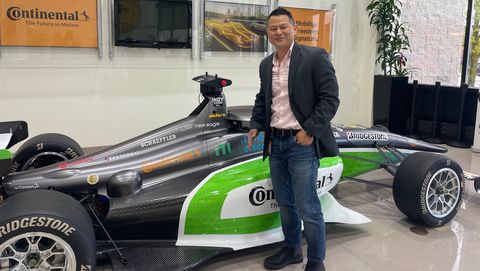- Indy Autonomous Challenge is a collaborative effort between public-private partnerships and academic institutions.
- The IAC showcases head-to-head autonomous racing and the future of autonomous mobility.
- In addition, lessons learned in the series can help make both race-car drivers and commuters on the interstate safer.
It wasn’t exactly Danny Sullivan’s famed 1985 Indy 500 “Spin and Win,” but the nifty maneuver an Indy Autonomous Challenge car executed at Las Vegas Motor Speedway each of the past two years left heads spinning all right.
Even if the car that spun didn’t win.
While the Technical University of Munich team (TUM Autonomous Motorsport) came up just short in the big Autonomous Challenge at CES earlier this year and in 2022—the PoliMOVE car, programmed by students from Politecnico di Milano and the University of Alabama, overtook its car late to triumph both times—it was impossible to not come away impressed by its actions in demonstrating the IAC’s ultimate mission.
The Indy Autonomous Challenge, a collaborative effort between public-private partnerships and academic institutions now in its third year, showcases head-to-head autonomous racing and the future of autonomous mobility while helping to make both race-car drivers and commuters on the interstate safer.
Last but not least, IAC provides STEM opportunities for the next generation.
That controlled spin the German squad twice pulled off—consider, the teams, mostly made up of Ph.D. students, have no physical contact with their cars during a race—still has folks talking.
“I don’t know if they are just showing off that they can do safety real well, but both events ended the same way, with (PoliMOVE) making an overtake at a high speed—the first time it was 169 mph, this time 175-178—and the German car spins out,” said Paul Mitchell, chairman and president of the IAC, during a recent sit-down to talk about the series and show off an IAC car at the North American HQ of one of its partners, Continental, in Auburn Hills, Michigan. “But it’s this amazing safety spin that it’s programmed to do when it loses control rather than careen into a wall. And both times there’s been no damage to the German car, and it comes to a nice stop on the track.”
That’s the IAC in a nutshell: safety first, even at nearly 200 mph.
What the nine participating teams comprising 21 universities from nine countries learn at such events—only two cars compete at a time in a bracket-style setup, with one “attacking” and one “defending” as they try to pass each other at ever-increasing speeds—and during the months of practice, programming, and preparation they put in leading up to them can be applied to making safer the racing series with, you know, humans in the cars. And at the same time they’re making contributions to the development and evolution of advanced driver-assistance systems (ADAS) we’ve all probably used at this point in our daily driving, whether it be blind-spot monitoring or your car’s backup camera.
There’s what it’s not about as well.
“The biggest misconception is that we have some objective to replace human race-car drivers or even compete head to head with them,” Mitchell said. “It’s not even something we would aspire to see happen. Our primary focus with motorsports is (doing work) that would allow for additional safety features to keep human race-car drivers safer and compete at even higher speeds.”
Also of note:
• These are not EVs.
• They’re not really big radio-controlled cars, either.
• They are real-deal Indy NXT race cars—Dallara AV-21s, specifically—with a whole mess of highly technical equipment and control software—including but not limited to lidar, radar, GPS/GNSS, drive-by-wire, wireless communication telemetry systems, and supercomputers—carefully crammed into and around the cockpit of these approximately million-dollar machines.
“I hope we’re waking individuals up to the fact that autonomous systems can operate at high speeds and in extreme conditions. Hopefully it helps with any fears they have, not just of a fully autonomous vehicle, but the ability to turn on and utilize Level 2, Level 3 safety systems, eventually Level 4,” Mitchell said. “So I think it’s about getting that exposure but in a familiar and exciting way. The feeling is, if a car can go 170, 180 mph and pass another car and operate even close to what a race-car driver can do, then maybe (these systems) can help me go 70 mph in the darkness, on the highway, sometime.”
While these autonomous cars are not EVs—their internal-combustion engine does get some help from a lithium-ion battery—Vinh Tran, vice president, head of Market Americas at Business Area Autonomous Mobility with Continental, says there are similarities in the need to get people used to the idea of both.
“Getting to Level 4 (Level 5 is complete autonomy), it will take time, but so will EVs. How many people do you know that drive EVs? There are a number, certainly, but in my circle, it’s ‘I love this adaptive cruise control!’ and we’re past that already.”
“I think the original novelty you saw pre-pandemic about this sort of race to Level 5, the autonomous robot car, was maybe more about a technical, competitive nature and a sort of aspirational scientific future,” said Mitchell, who noted more than a million people die in car accidents worldwide each year. “The reality is, if we’re saving lives, if you’re reducing mortality, I think that’s the collective goal of the industry and it’s our contribution in the Autonomous Challenge.”
The IAC’s next event is June 16-18 at the Milano Monza Motor Show in Italy. To learn more about the series, visit indyautonomouschallenge.com.
Read the full article here



